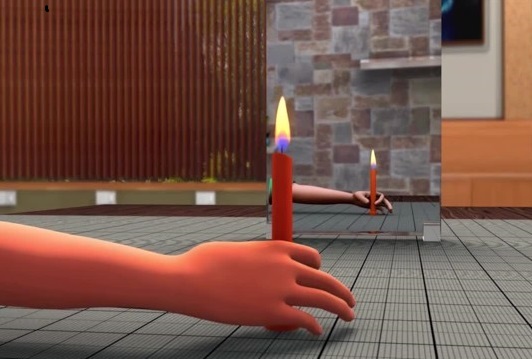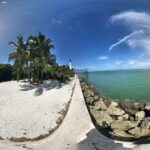Why is an Image Formed?
In Lesson 1 of this unit of the Physics Classroom Tutorial, the manner in which light reflected off objects in order to allow us to see them was discussed. A major principle in that lesson was expressed as follows:
In order to view an object, you must sight along a line at that object; and when you do light will come from that object to your eye along the line of sight.
This very principle can be extended to the task of viewing the image of an object in a plane (i.e., flat) mirror:
In order to see the image of an object in a mirror, you must sight at the image; when you sight at the image, light will come to your eye along that line of sight.
The image location is thus located at that position where observers are sighting when viewing the image of an object. It is the location behind the mirror where all the light appears to diverge from. In the diagram below, three individuals are sighting at the image of an object along three different lines of sight. Each person sees the image due to the reflection of light off the mirror in accordance with the law of reflection. When each line of sight is extended backwards, each line will intersect at the same point. This point is the image point of the object.

Locating an Image via Parallax
This principle can be illustrated in a Physics class using a 5-foot plane mirror and a pair of large cylinders. One cylinder is placed in front of the mirror and students from different locations in the room are asked to sight at its image. The second cylinder is then aligned along the line of sight and readjusted until it is in line with each person’s line of sight. Regardless of who is viewing the image and from where they are viewing the image, each sight line must intersect in the same location. It is possible that the second cylinder is aligned with one student’s line of sight but not with another student’s. If this is so, then the cylinder is not placed at the exact location of the image. This is depicted in the diagram below.

In a case such as this, the cylinder position is adjusted until it is located at the position where all students in the classroom can see it extending above the mirror and in line with the image that each student sees when looking in the mirror. Only, then can we conclude the cylinder is located at the image position.
Who Can See an Image?
Since there is only one image for an object placed in front of a plane mirror, it is reasonable that every sight line would intersect in a single location. This location of intersection is known as the image location. The image location is simply the one location in space where it seems to every observer that the light is diverging from. Regardless of where the observer is located, when the observer sights at the image location, the observer is sighting along a line towards the same location that all other observers are sighting. And as mentioned in an earlier lesson, the perpendicular distance from this image location to the mirror is equal to the perpendicular distance from the object location to the mirror. In fact, the image location is directly across the mirror from the object location and an equal distance from the mirror.

Of course, it is possible that certain individuals in the room will be unable to view the image of an object in a plane mirror. Because of the person’s position relative to the image position and to the extremities of the mirror, the person is unable to detect a ray of light reflecting to their eye as they sight at the image location. This does not mean that there is no image. Indeed, any object positioned in front of a plane mirror (or even to the side of the plane mirror) has an image regardless of whether there are people positioned in an appropriate location to view it. In the diagram below, there is an image of an object located on the other side of the mirror. However, Ray Zuvlite is unable to view the image due to his position in the room. Ray is certainly able to sight in the direction of the image location. However, the light from the object is unable to reflect off the mirror in accordance with the law of reflection and travel to his eye along his line of sight. Since light from the object does not make it to his eye, Ray is unable to see the image of the object in the mirror.

Of course, this problem could be remedied if the mirror were wider, if the object were moved to the left or closer to the mirror, and/or if Ray moved to the left. Repositioning the object, the mirror, and/or the person could result in a ray of light from the object reflecting off the mirror and traveling to Ray’s eye. The diagram below depicts this remedy.

How Does Reflection Lead to the Formation of Images?
So why is an image formed by a plane mirror? An image is formed because light emanates from an object in a variety of directions. Some of this light (which we represent by rays) reaches the mirror and reflects off the mirror according to the law of reflection. Each one of these rays of light can be extended backwards behind the mirror where they will all intersect at a point (the image point). Any person who is positioned along the line of one of these reflected rays can sight along the line and view the image – a representation of the object.

This principle of image formation is often applied in a Physics lab. Suppose that a mirror is placed on a sheet of paper that is placed on top of a piece of cardboard. A pin is positioned in an upright position (and held in place by the cardboard) at a location in front of the mirror. A student can sight along a line at the image of the pin from a variety of locations. With one eye closed, a straightedge is used to assist in drawing the lines of sight. These lines of sight are drawn from a variety of sighting locations. Each line of sight can be extended backwards beyond the mirror. If the sight lines are drawn correctly, then each line will intersect at the same location. The location of intersection of all sight lines is the image location. Validation of the accuracy of your sighting and ray tracing can be accomplished by measuring angles of incidence and angles of reflection on the diagram. These should be equal for each individual sight line. That is, angle A should equal angle B; angle C should equal angle D; and angle E should equal angle F. Finally, the object distance can be compared to the image distance; these should also be equal.



